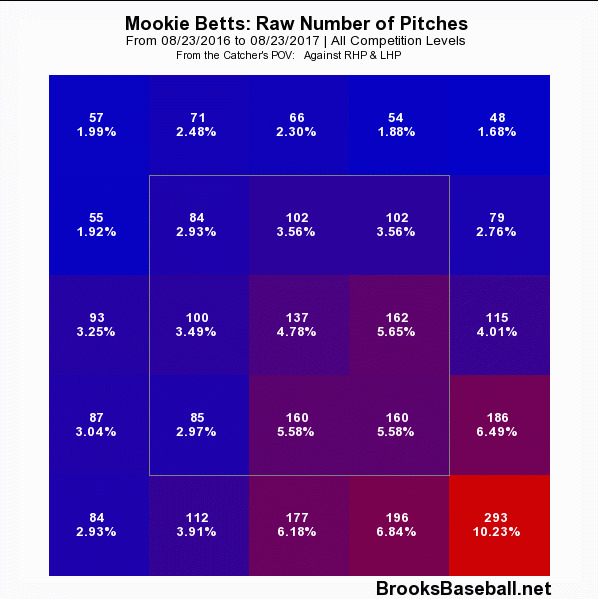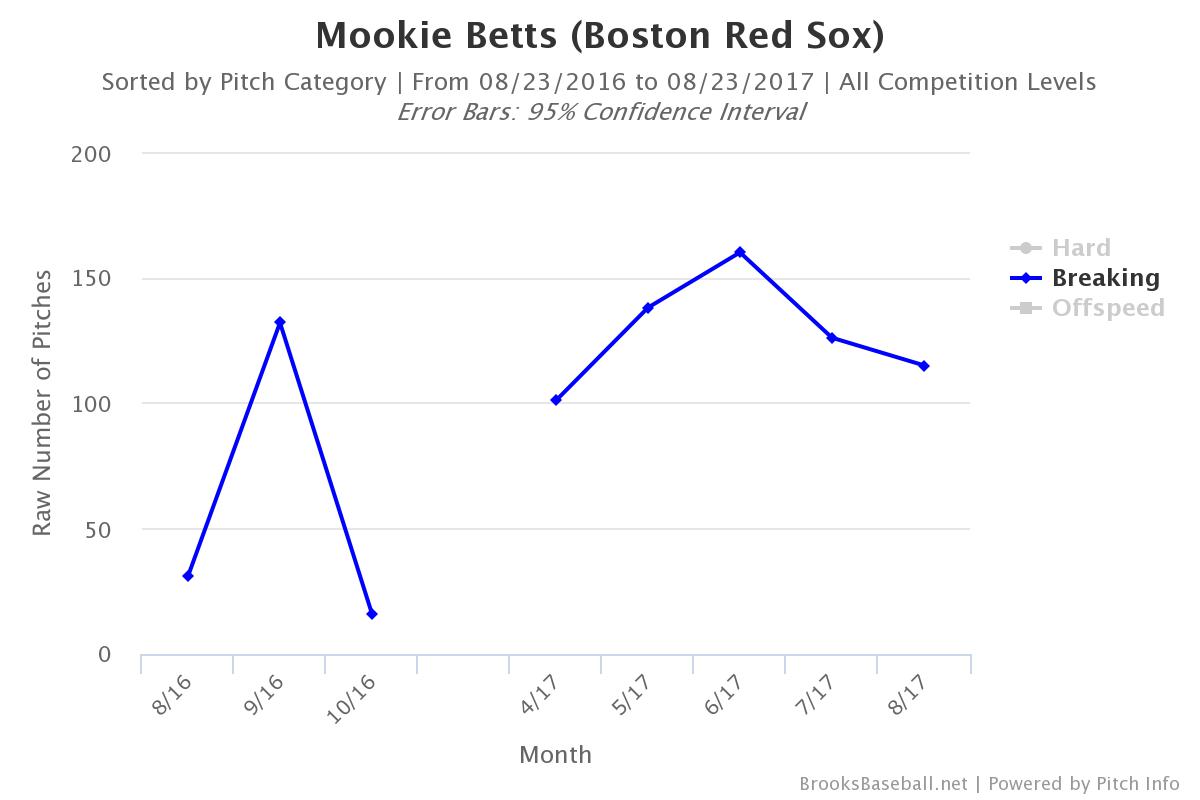I’m having some real trouble coming to terms with Mookie Betts’ season.
One one hand, Betts’ is still a pretty amazing baseball player. This year, he’s on pace to be a five-to-six win player – depending on where you look – and continues to be lights out in the outfield and dynamite on the basepaths. He’s hit more for power than anyone thought he would, which always makes for a nice surprise. He’s also only 24 years old. He’s a homegrown, All-Star-caliber talent who figures to be firmly planted in Fenway’s right field for years to come, no matter how many times Bill Simmons’ dad says otherwise.
With that said, I can’t shake feeling underwhelmed by Betts’ season. Heading into last night’s game, Betts was hitting .264/.341/.443 on the year with a .784 OPS. That’s by no means bad, it’s not exactly good either. Based on his wRC+, (101) Betts has been – quite literally – average at the plate this year. August hasn’t been kind to him either, as he’s hitting just .221/.321/.324 with a .645 OPS since July ended. While Betts is absolutely not a .221 hitter, it’s not as if his performance at the plate this season inspires a lot of confidence that a monster September is around the corner.
A recent conversation between that sassy anonymous Red Sox stats Twitter account and Pete Abraham (I follow them both, whatever) got me thinking:
.643 OPS since the break. Either it’s a crap season or he and Hanley will go nuts the rest of the way
— Pete Abraham (@PeteAbe) August 23, 2017
So, what’s it going to be? Is this year just a down year for Betts? (And for that matter – could we really expect him to perform to the level of 2016 again this season?) Or is the Red Sox’s best player about to go on a tear? Let’s take a look.
HE’LL BE FINE
At first glance, this season certainly looks like an aberration for Betts. With BABIP still being the clearest indication for how lucky/unlucky a player is, Red Sox fans can breathe a sigh of relief when they see Betts’ BABIP compared to years past:
- 2014: .327
- 2015: .310
- 2016: .322
- 2017: .266
So, clearly, luck has played somewhat of a negative factor in Betts’ season. His BABIP during his particularly cold August has been .241, so something’s gotta give. There’s inevitably some return to form coming, even if it’s closer to .266 than anywhere above .300.
Another promising indication that Betts is coming around is his contact numbers. This year, despite his struggles, Betts is still hitting the ball hard (35 percent hard-hit percentage) as relative to his career average (33 percent). The rate of softly hit balls (19 percent soft-hit percentage) is pretty close to his career average (17 percent) as well. He’s hitting line drives three percent less and fly balls three percent more often, but generally, his batting profile remains unchanged. His strikeouts are staying steady at roughly 10 percent, too. He’s also walking almost four percentage points more, for what that’s worth. Put all together, and Betts isn’t striking out more – he’s hitting the ball just as hard as he was during his MVP-caliber season, and has gotten unusually unlucky this season.
All of these things, plus the generally accepted notion that he’s just not a .241 hitter, point towards positive regression.
THIS IS WHO MOOKIE BETTS IS
I should preface this by saying that what I’m referring to is his .264/.341/.443 stat line when I say that – not his August slump. So while, personally, I think 2015 Mookie Betts (.291/.341/.479 with a .820 OPS) is the most realistic iteration, there are some concerning trends that hint at real warts.
First, there are the sliders. Betts has fits with sliders away, and take a look where he’s getting sliders over the last calendar year:
Now, as you can tell, a good portion of those sliders aren’t strikes. Now take a look at how his approach to sliders has changed over the same time period:
Granted, the chart’s a little noisy. But you can see that a significant, if not most, of this season has seen Betts whiffing at breaking balls at a higher clip than he was last year. He’s also getting a lot more breaking balls this season:
(Brooks Baseball doesn’t specify Slider/Curve when it comes to these charts, but by taking a look at the breakdown of what breaking balls Betts has been facing in the last calendar year, you can clearly see that it’s mostly sliders.)
So, he’s getting more sliders, and missing them more often. Why isn’t that showing up in his strikeout rate? My guess is that the increase of sliders off the edge plays into his rising walk rate. Sure, he’s getting hurt on good sliders, which are coming with more frequency. But not all the sliders he sees are good, and it would make sense that laying off bad ones would tie into drawing more walks.
When it’s not chasing sliders out of the zone, Betts’ other weak point is popping the ball up. This year, he’s hitting infield flies roughly 15 percent of the time – up three percentage points from last year. That current clip would put him at 15th-worst in baseball. Infield flies don’t show the complete picture when it comes to popping the ball up, but Betts has continue to hit more and more infield flies with each passing season. If anything, it’s a trend to keep your eye on.
VERDICT
I think he’s going to be fine. Think about these four aspects of Betts’ season:
- His walks are up over five percentage points
- He’s swinging almost five percentage points less often
- His BABIP is abnormally low
- He’s making the same amount of good contact
The popping up and lack of slider recognition both deserve real concern; baseball is a game of adjustments and if Betts’ doesn’t figure out how to lay off sliders low and away, he’s going to be a .240 hitter. But the numbers point towards a rebound, and he is Mookie Betts, after all. His next Feat just has to be adjusting.
Photo by Winslow Townson – USA TODAY Sports



